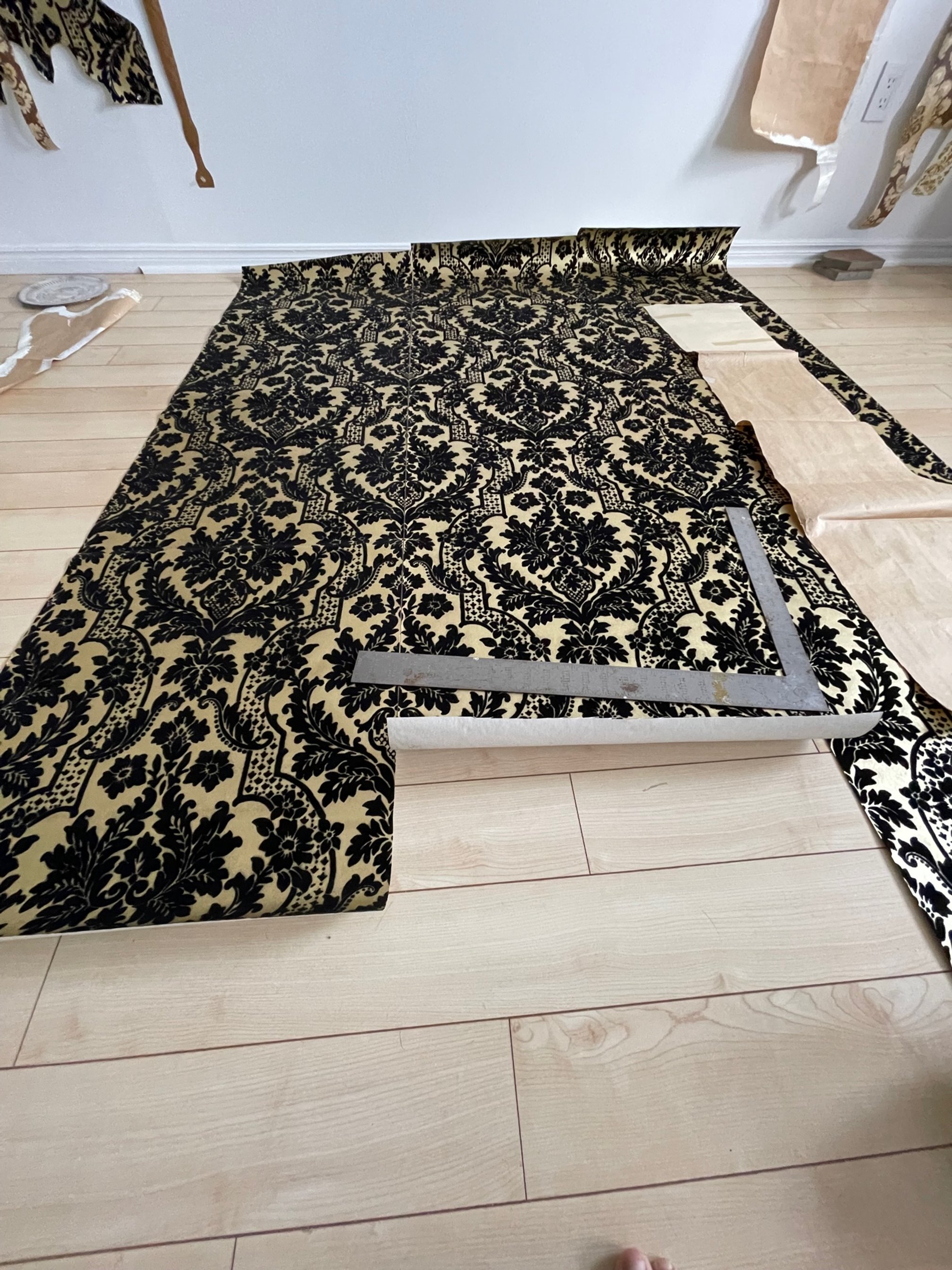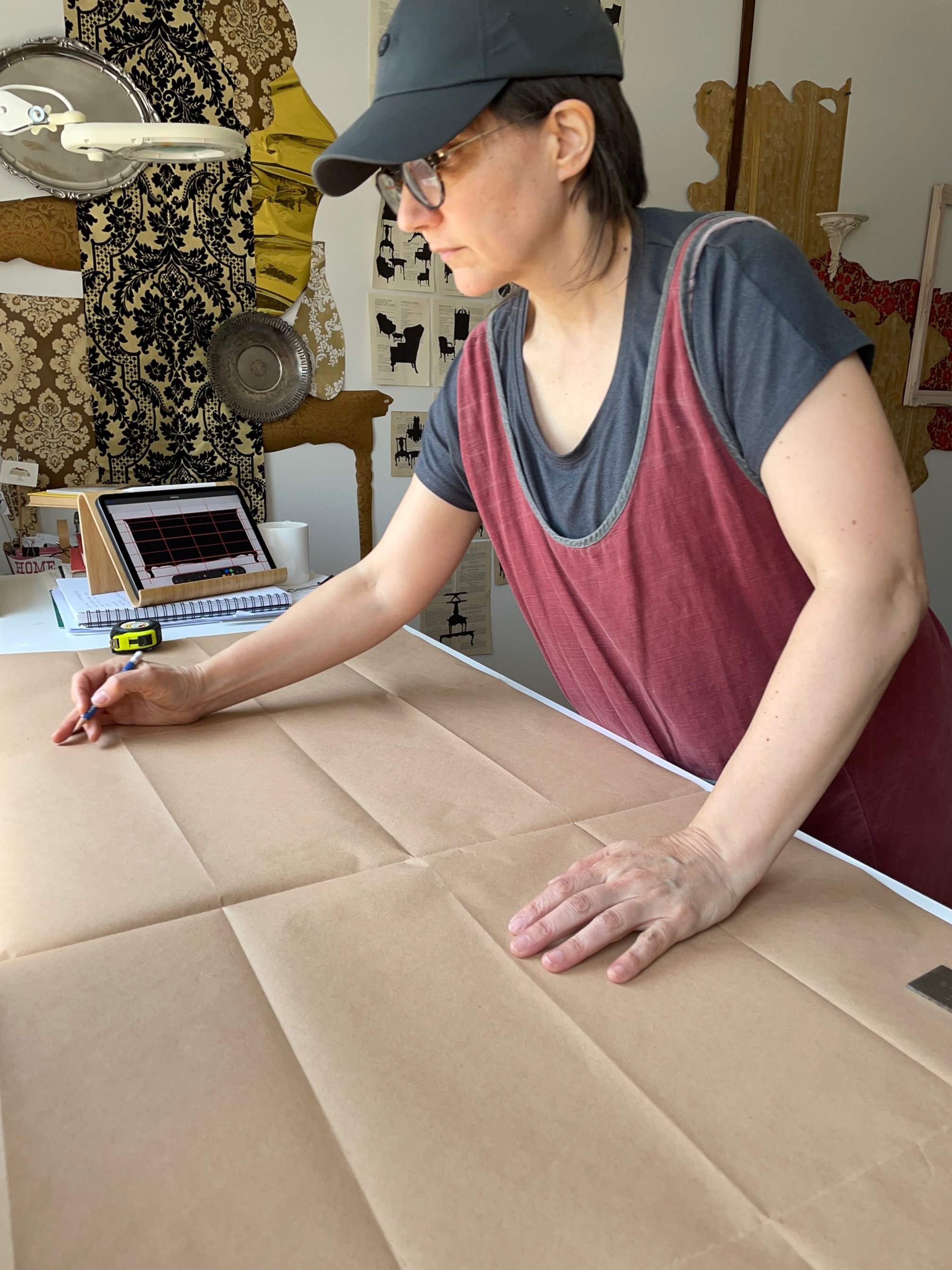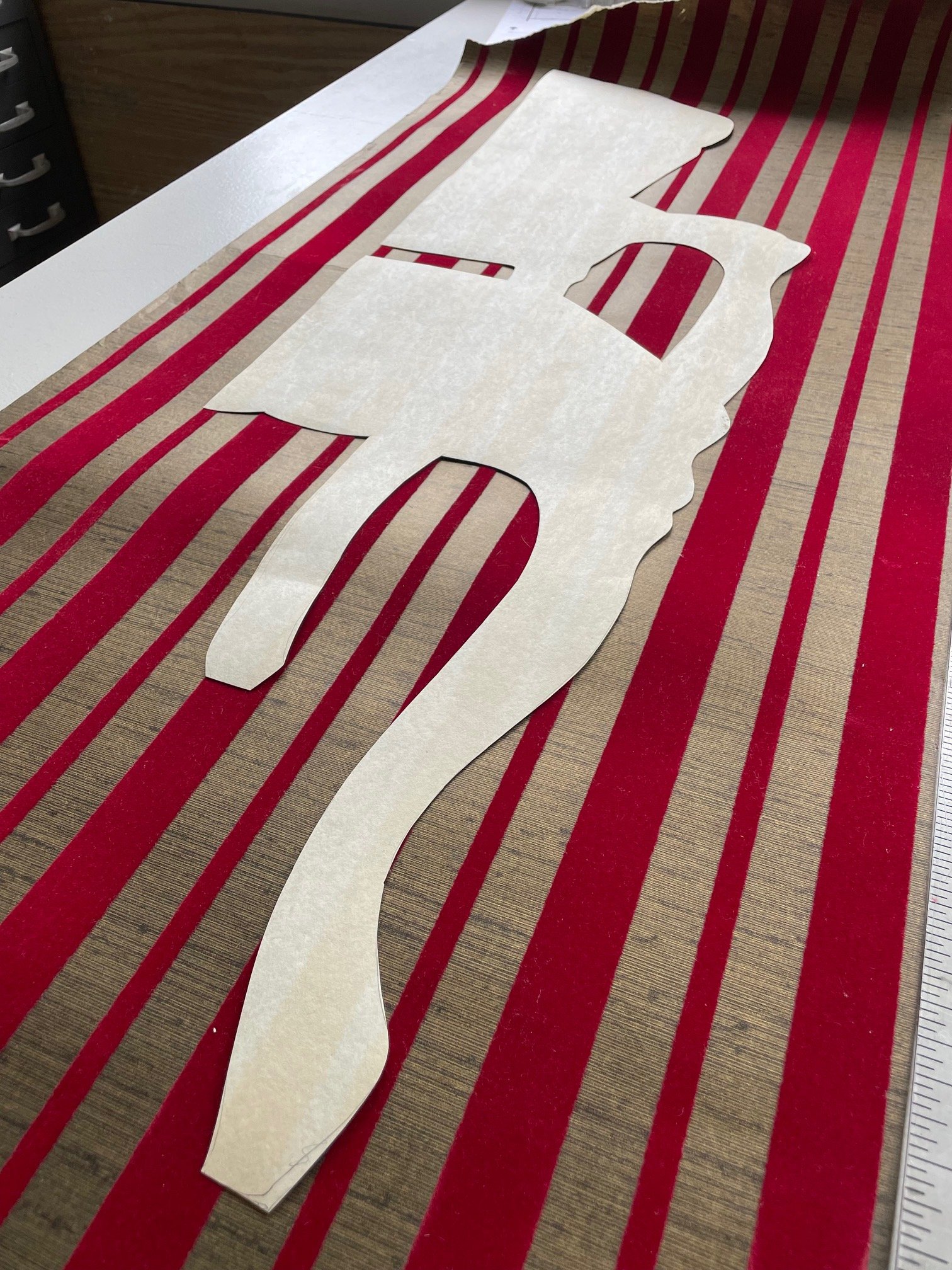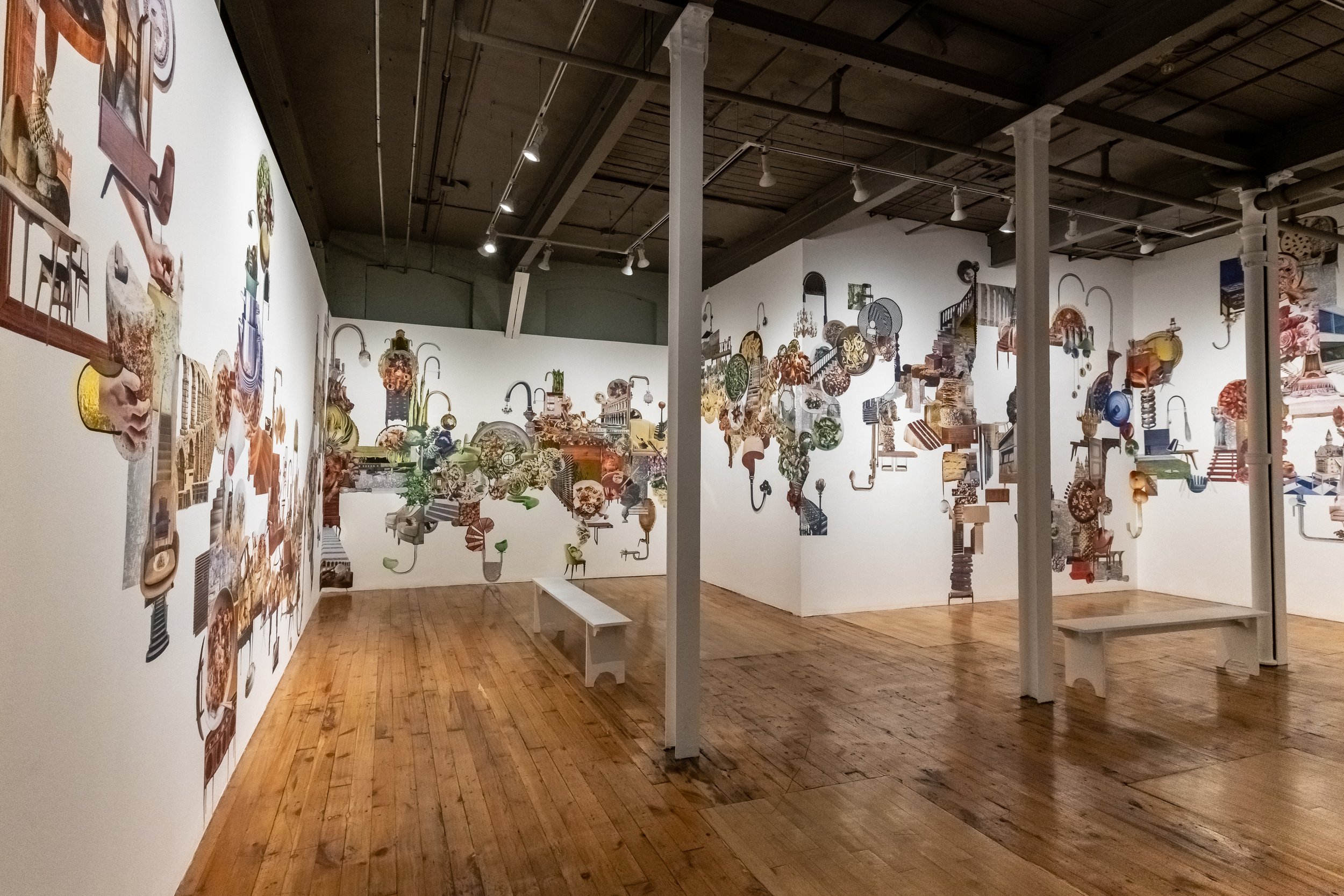During a studio visit with artist Tonia Di Risio, my eyes dart around the room, from heaps of lush vintage wallpaper to dismantled furniture pieces, from drawings on recipe pages to a sweet studio cat. I’m warned that the cat, affectionately named Rosie, will not allow herself to be pet and will keep her distance. Di Risio is preparing for a show at Red Head Gallery and there’s a buzz of work in progress. An artist’s studio is an intimate place, and it’s a privilege to visit during a critical time when fluid ideas are developing. There’s a lot going on here. I take note of the infinite inspiration Di Risio finds in exploring home. I also take note of her process: she challenges her work with a range of domestic materials, chopping a coffee table in half and reading vintage recipes for comfort. Rosie slowly inches closer. Di Risio and I have good conversation and make connections about food, art, gardening, thrifting, family, furniture, and small villages in Italy. By the end of the studio visit, Rosie has made her way across the room and is beside me, purring and nuzzling my arm—she’s stepped out of her comfort zone and is rewarded. Rosie’s acceptance not only makes this studio visit a real treat, but this gutsy little creature also leads me to reflect on some ideas: comfort, challenge, risk, and reward. And I begin to look at Di Risio’s work with these thoughts in mind.
Tonia Di Risio studio featuring Rosie, 2023, documented by Tonia Di Risio
In Tracings Revisited, Di Risio explores memories of her late grandmother’s home. Di Risio lived in her Italian grandmother’s home when she was a child and holds fond memories of the space. Reflecting on furniture pieces, the artist assembles shapes of couches, commodes, tables, and chairs into large-scale collages, or draws them on loose recipe book pages.
With the large collages, the furniture tracings are to scale. The shapes are traced onto wallpaper, cut out, and then assembled flat on a wall. The artist uses an assortment of vintage wallpapers that are heavily patterned with velvety flock and shimmering surfaces, both of which create a busy surface of golds, reds, and blacks. Decorative objects are then layered onto the cutouts: silver serving trays, a garish brass lamp with a cherub, a halved coffee table, and an open drawer animate the flatness of the cutouts. Di Risio constantly thrifts for things that reflect an ornamental style similar to her grandmother’s.
Artist’s studio, 2023, documented by Tonia Di Risio
On the loose book pages titled 105, Di Risio continues to trace furniture shapes on hundreds of pages of traditional Italian recipes from North American cookbooks. This time, the tracings are scaled down and rendered in black marker. Black silhouette shapes obstruct the ingredients list and cooking instructions: recipes like Eggplant Parmigiana on page 403 and Chicken Cacciatore on page 151 are blocked with dark curvy shapes of Chippendale chairs, French commodes, and Queen Anne highboys.
Tracings, 1999, installation view, by Tonia Di Risio, Documentation by Robert Zingone
Gorge, 2019, Installation view at Red Head Gallery
Hand-cut collage and mixed media by Tonia Di RIsio
Picture by Peggy Taylor Reid
Over the years, Di Risio’s art practice has explored themes of housekeeping, home maintenance, food preparation, and interior decoration as a way of examining how identities are formed in relation to ethnicity. Tracings Revisited returns to an earlier body of work titled Tracings (1999-2000), where the artist traced her grandmother’s furniture and decorative objects. In this previous work, the cutouts were used as templates to paint the walls of an empty room for a site-specific installation. Gloomy colors of pale-yellow silhouettes on somber yellow walls filled the space with a shadowy caress of the past staining the present. Tracings Revisited also continues Di Risio’s interest in working with Italian recipes, as seen in Feed (2006), where the artist made a series of recordings of women in her family preparing traditional recipes. And finally, Tracings Revisited builds on her ongoing collage work, which over the trajectory of her practice has evolved. Early collages like Parts and Labour (2015) were made in a controlled and manageable scale on sheets of paper; later collages like Spread (2017) and Gorge (2019) expand into immersive wall-size installations that spill and flow across space.
Reflecting on the work of Di Risio, I ponder how Tracings Revisited takes great artistic risks that are followed by bountiful artistic rewards. Di Risio draws inspiration from her Italian heritage, finding security and solace in the familiar spaces of her culture; but as she draws comfort from those familiar spaces, she is also challenged by feelings of loss, aware that her Italian heritage is dissolving and diffusing, diluted by mainstream North American culture. Tracings Revisited is the first body of work Di Risio made about her grandmother since she passed away, and the collages’ shifting, restaging, and flattening of objects reference the changes in her grandmother’s home. She conflates home décor with grief, which leads to a courageous unearthing of new ideas. Even the dark silhouettes, acting to redact valuable information from Italian-North American recipes, evoke a sense of loss: Italian grandmothers verbally pass down recipes, which evolve with the additions of each generation, a tradition that is lost as time passes. While these drawings don’t operate in the traditional world of collage (as there’s no cutting and pasting), the black shapes suggest the collage process of bringing scissors to pages of printed material and leaving a void. Once again, the artist expands her expression of collage.
Tracings Revisited Gallery wall, tracings on found cookbook pages, 2023, Tonia Di Risio
Di Risio’s childhood home is the foundation for much of her art practice. Home is a space of imagination, reverie, and play. In his book The Poetics of Space, Gaston Bachelard discusses how the house we are born in “is more than an embodiment of home, it is also an embodiment of dream.” Every space of a home—from the tidy living room to the kitchen junk drawer—is a resting place for daydreaming. Tracings Revisited visits this special place of rooms, corners, furniture, objects, and drawers, this special place where Di Risio finds “nothing is ever empty.”
Fausta is a photo-based artist, curator, and professor of photography in the Art and Art History Program at University of Toronto Mississauga and Sheridan College. She received her BA from the University of Toronto and her MFA from Lesley University in Cambridge, Massachusetts. Her artwork explores material culture and the relationships we have with objects.











